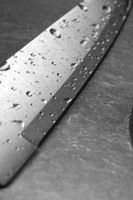
Kitchen Knives
Tips For Keeping Your Kitchen Knives In Good Shape
Preparing your favourite Chicken Recipe will require some Kitchen Knives. were designed for cutting, but are often used for a number of other purposes for which they were not designed. How often do you grab the nearest of your kitchen knives when you need a can opener, chisel, screwdriver, pry bar or any other heavy-duty tool replacement?

The problem is that when you have to cut something in a hurry and the knife (that has now become the general household maintenance tool) is now blunt, so you apply more pressure and it slips and cuts you instead.
Knife Maintenance Tips
There are some basic kitchen knife care instructions that will help your knives to serve you more effectively and for longer.
Sharp Tips
- Use your knives for what they are designed for - to chop or cut - not to open bottles of wine and cans.
- Never put kitchen knives in the dishwasher or leave them in the sink to soak.
- wash in mild soapy water by hand and don't let the blades touch or bump other objects as this can damage the knife blade.
- Store knives in a knife block or on a magnetic knife rack.
- Wipe your knife well after working with acidic food to prevent staining or spotting.
- Invest in a good knife sharpener and sharpen your knife just before use. It'll keep your knives in good working order.
- Knives should be professionally sharpened every two to three years.
- In the interest of hygiene, always use a clean chopping board for each job and wash boards thoroughly between chopping.
Three Knives Every Chef should have.
Good kitchen knives can be quite an investment but they do make life easier when cooking.
- 6 to 12 inch chef's knife - a general knife or kitchen workhorse used for almost all cuting jobs- chopping, slicing, dicing and mincing.For speed when chopping, expert chefs use a fingertip to press down on and anchor the tip and then pivot the knife around this point.
- 3 or 4 inch paring knife - used for trimming and preparing vegetables and fruit. It's hooked blade is an advantage for peeling and shaping but a disadvantage for straight cutting but you could also purchase a straight edged paring knife..
- 7 to 10 inch utilty knife - for slicing large objects such as loaves of bread, turkey breasts, roasts, etc. Sometimes useful with serrated edges so they can grip tomatoes and soft-skinned fruits, but the serrations make them less useful for making clean cuts.
There are other optionals for more specific jobs that are nice to have.
- boning knife - designed for cutting meat from bones.
- meat cleaver - heavy duty meat and bone cutting and chopping jobs.
- bread knife - for cutting breads and cakes.
- electric knife - extremely useful for carving and cutting.
See my tips for buying Chicken and cooking chicken.
Cooking Tips Mainpage
Top Of Kitchen Knives
Chicken Recipes Homepage





